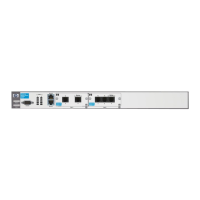B-26
Appendix B: Glossary
Interface A boundary across which two independent entities or systems meet and
communicate.
IP Internet Protocol. A Network Layer (Layer 3) protocol that controls how
packets of data are addressed and routed from one device to another. IP is the
network protocol used on the Internet, as well as in many private networks.
Each host on the Internet has at least one IP address that uniquely identifies
it. For more information, see RFC 791 (at http://www.ietf.org/rfc/rfc0791.txt).
IPCP IP Control Protocol. An NCP in the PPP suite. Peers that are establishing a
PPP session exchange IPCP frames to signal that PPP frames will encapsulate
IP packets. IPCP frames also negotiate configuration options for the IP
packets. IPCP uses the same exchange mechanism as the PPP Link Control
Protocol (LCP). For more information on IPCP, see RFC 1332 (at http://
www.ietf.org/rfc/rfc1332.txt).
IP Precedence A value within the IP header used to grant certain packets priority over other
packets. A higher IP precedence value in a packet’s header requests better
QoS for that packet. The type of service actually granted to the packet depends
on the QoS mechanisms configured in a network. IP precedence is often used
with WFQ—packets in a traffic flow with a higher precedence receive rela-
tively more bandwidth—or with LLQ—the packet receives priority handling
instead of being sent to the end of the queue on each network node. For more
information on the IP Precedence field in the IP header, see RFC 1812 (at http:/
/www.ietf.org/rfc/rfc1812.txt).
IPSec IP Security. A set of protocols that supports the secure exchange of packets
at the IP layer. For example, devices can use IPSec to establish a virtual private
network (VPN) through an untrusted IP network such as the Internet. The
VPN connection, secure by IPSec, can connect remote sites or provide indi-
vidual remote users access to the private network through their Internet
connections. For more information on IPSec, see RFC 2401 (at http://
www.ietf.org/rfc/rfc2401.txt).
IPv4 Internet Protocol version 4. The Internet addressing scheme currently in use.
IPv4 uses four octets (32 bits) of address space, which means that it provides
2
32
addresses. An IPv4 IP address is typically represented as four digital
numbers, each representing one octet. Every host on the Internet must have
a unique IP address, but because of the way IPv4 addresses were distributed
as large blocks of addresses in a classful network, there are not enough free
IP addresses to meet growing demand.
IPv6 Internet Protocol version 6. The emerging Internet addressing scheme. IPv6
addresses are 128 bits in length, typically denoted as eight two-digit hex
numbers followed by a CIDR notation prefix length.

